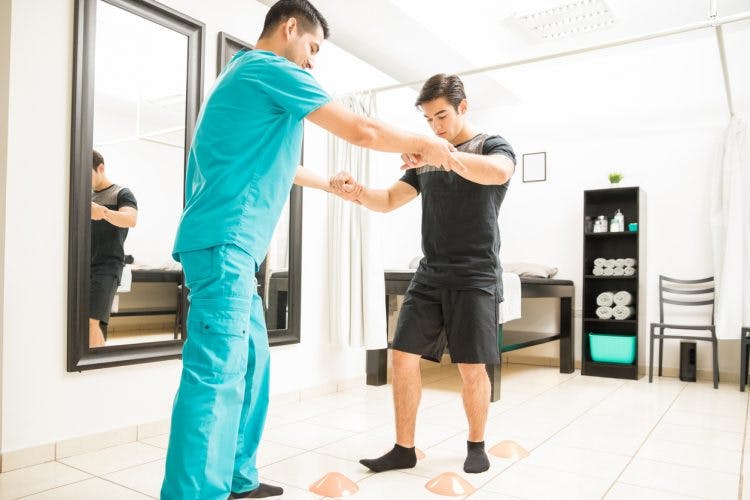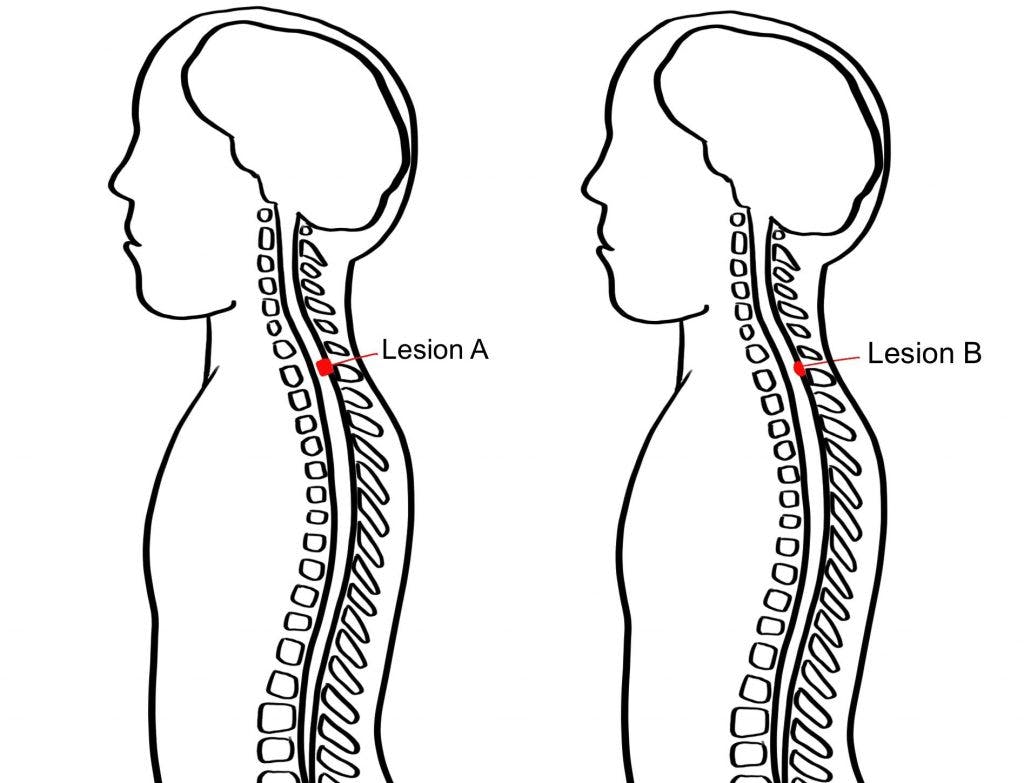No products in the cart.
No products in the cart.
No products in the cart.
No products in the cart.
Home » Neurological Recovery Blog » Spinal Cord Injury » Quadriplegic Recovery: How It Works & Recovery Stories
Last updated on October 21, 2021

Quadriplegia describes paralysis in both the upper and lower extremities. It’s generally the result of injury to the cervical region of the spinal cord (the area that makes up your neck). Depending on the type and severity of injury, quadriplegia can leave individuals permanently paralyzed, but it can also be milder and have a greater potential for recovery.
To help you understand how to recover from quadriplegia, this article will discuss:
For many, recovering from quadriplegia after incomplete spinal cord injury is possible, while the motor/sensory recovery outlook following a complete spinal cord injury is less favorable. Ultimately, individuals with SCI must retrain their body, brain, and spinal cord to work in sync again.
One of the most crucial parts of recovering from quadriplegia is to be aware of your body. This means keeping track of returning sensations or movements and developing them through massed practice. Every time you move, the spinal cord is stimulated. The more you repeat weakened movements, the better the spinal cord gets at understanding there is a demand for them.
This encourages undamaged regions of your spinal cord to utilize neuroplasticity (its ability to rewire its neural circuitry) to recover affected movements. With consistent practice, these new connections get stronger and the movements begin to feel more natural.
However, it’s important to keep in mind that not all individuals are able to recover mobility after spinal cord injury. The following section will discuss the various factors involved in determining recovery outlook.
The recovery outcomes of every spinal cord injury will vary based on the completeness of injury and how aggressively recovery is pursued.
Below, we’ll discuss the various factors that can affect one’s potential to recover from quadriplegia.

The severity of a spinal cord injury will depend on how complete the lesion is. A complete spinal cord injury indicates that all movement and sensation below the level of injury has been lost. This occurs when all neural pathways at the level of injury are damaged, resulting in no spared connections between the brain and areas below the level of injury.
In contrast, an incomplete injury results in some degree of movement and/or sensation being spared below the level of injury, as some neural connections at the level of injury remain intact. For example, looking at the picture above, Lesion A is going to result in more weakness than Lesion B because more neural pathways are going to be interrupted.
The more weakness or paralysis, the more functions will need to be recovered. As long as the injury is incomplete (the spinal cord is not severed all the way through), motor recovery to some degree is possible.
Individuals who have sustained a complete spinal cord injury are generally unable to regain lost movement and sensation due to the inability to utilize neuroplasticity. Although there are some promising solutions currently being researched, the loss of mobility and sensation after a complete spinal cord injury is usually considered permanent.
However, even though they may not recover their mobility or sensation, there are many adaptive techniques and devices that individuals with complete SCIs can utilize to optimize their functional independence and quality of life.
SCI patients with less severe quadriplegia may be able to move their arms and hands with weakness, while those with more severe quadriplegia may not be able to move their arms at all.
The higher your level of injury, the more parts of your upper body will be affected. For example, a C4 SCI patient will experience paralysis from the shoulders down while a C8 SCI patient will be able to move their arms, with some impaired hand function.

Rehabilitation for quadriplegia after spinal cord injury consists of physical and occupational therapy.
Physical therapy will use exercise to strengthen your muscles, improve range of motion, and build endurance. Individuals with incomplete quadriplegia may be able to move certain parts of their arms, legs, or torso and will need physical therapy to improve those functions.
Occupational therapy will teach you how to adjust to everyday life with an SCI by focusing on activities of daily living like eating, toileting, and grooming.
Those with more severe quadriplegia will likely need a caregiver to help them with these activities, while those with less severe quadriplegia may be able to regain independence by strengthening their bodies, learning how to use adaptive tools, and learning specific ways to move to accomplish these daily tasks.
Additionally, in some severe cases of higher-level SCI where speaking, breathing, and/or swallowing functions have been impacted, speech therapy rehabilitation may also be involved.
Generally, the most progress in recovery from quadriplegia is seen within the first 6 to 12 months after injury. This is because the central nervous system experiences an increased state of plasticity after injury.
However, it’s important to understand that there is always potential to recover from an incomplete spinal cord injury, if you’re willing to put in the work. Even after that period of increased plasticity, your central nervous system is still capable of adapting and rewiring itself. Many spinal cord injury patients continue to see results years after their injury.
You might be in for a surprise if you experience spinal shock following your spinal cord injury. Spinal shock refers to the temporary loss of motor control, sensation, and reflexes below your level of injury.
It’s caused by swelling of the spinal cord. When your spinal cord experiences too much swelling, blood flow to areas below the injury can get cut off and cause the body to dysfunction. Once the swelling starts to die down, functions may gradually return and you will have a better indication of what you truly can and can’t control.
It’s important to consider spinal shock following a spinal cord injury because many people believe they have complete injuries due to the total loss of function; it isn’t until functions start to return that they find out it was spinal shock and that they actually have incomplete SCIs.
Need to see recovery from quadriplegia to believe it? Below, we’re sharing 2 recovery stories.
Keep in mind that every spinal cord injury is unique and results will vary from person to person. Everyone is on their own recovery journey, so it’s important to focus on intensive training and trust the process.
Hayden sustained a C4 spinal cord injury after getting tackled in a football game. He was paralyzed from his shoulders down and had to undergo surgery to stabilize his spinal cord. After three and a half months in an intensive rehabilitation program, he was able to walk again.
Kedar’s cervical spinal cord injury left him paralyzed from the chest down. The video above shows his rehabilitation progress over three years.
He gradually transitions from using a wheelchair to standing, from standing to training on parallel bars, from parallel bars to using a walker, and from walker to elbow crutches. Slowly, he was weaned off assistive devices and learned to walk on his own. Kedar proves that even years after spinal cord injury, quadriplegic recovery is possible if you continue to diligently work for it.
While it can be frightening to experience weakness or paralysis throughout the body, many individuals with quadriplegia after incomplete spinal cord injury are able to recover their mobility. Through consistent, task-specific, and intensive practice, individuals can retrain their spinal cord to make adaptive changes and improve movement patterns.
We hope this article helped you understand that recovery from quadriplegia is possible.

Get instant access to our free exercise ebook for SCI survivors. If you liked this post, you’ll LOVE our emails and ebook.
Each exercise features pictures of a licensed therapist to help guide you. You’ll also receive our popular recovery emails with SCI survivor stories and other useful tips — you can opt out anytime.
We will never sell your email address, and we never spam.


Flint Rehab is the leading global provider of gamified neurorehab tools. Check out our bestselling tool by clicking the button below:
Depending on the severity of your spinal cord injury, there may be hope for improved mobility. Consistent at-home therapy is key to making this happen.
That’s why Flint Rehab created FitMi, a motion-sensing, gamified home recovery tool designed for neurological injury like SCI.
Here’s what others have said about it:
“I purchased this wonderful equipment for the use of spasticity for my right hand. Initially I wasn’t sure if it would work because of the various treatments I tried and also many physiotherapists who tried their level best, but didn’t achieve any positive results.
However after trying FitMi, I could feel that slowly and steadily I am improving. It’s really a great device that minutely takes care of each and every muscle of your affected body part. The biggest plus point is, you can use this device anywhere, anytime with precise exercises that you need and also saves your money and time spent on your physiotherapist.“
— Chandrakiran
FitMi works by encouraging you to practice rehab exercises with high repetition. On average, survivors complete hundreds of repetitions per half hour session.
“Massed practice” like this helps stimulate and rewire the nervous system. While you can achieve massed practice with a written sheet of exercises, it can be tough to stick with it consistently — and consistency is key to recovery.
FitMi helps transform rehab exercises into an engaging, interactive experience. The yellow and blue “pucks” track your movement and provide feedback. All of this comes together for a motivating home therapy program.
A survivor named Tom put it perfectly:
“I believe this device will help me concentrate on making the repetitive actions needed to obtain further movement range in my wrist and hand and arm and therefore rating it with five stars. My occupational therapist recommended to give this a try. I have been using FitMi for just a few weeks. I feel more at ease in flexing.”
If you’d like to learn more about FitMi, click the button below:

Do you have this 15 pages PDF of SCI rehab exercises?
Get a free copy of our ebook Rehab Exercises for Spinal Cord Injury Recovery. Click here to get instant access.
Grab a free rehab exercise ebook!
Sign up to receive a free PDF ebook with recovery exercises for stroke, traumatic brain injury, or spinal cord injury below: